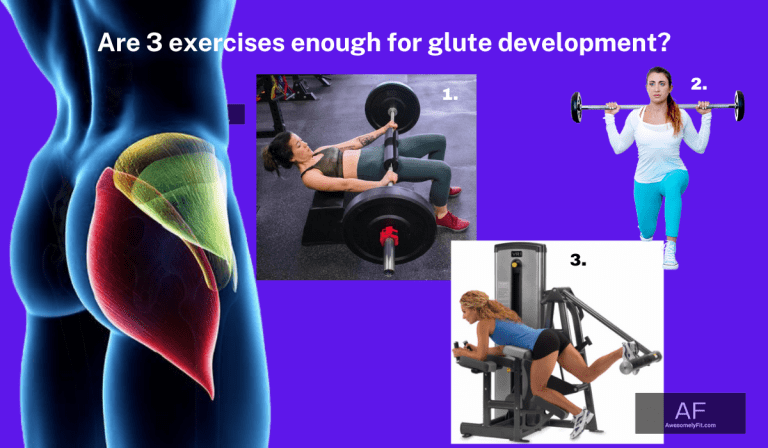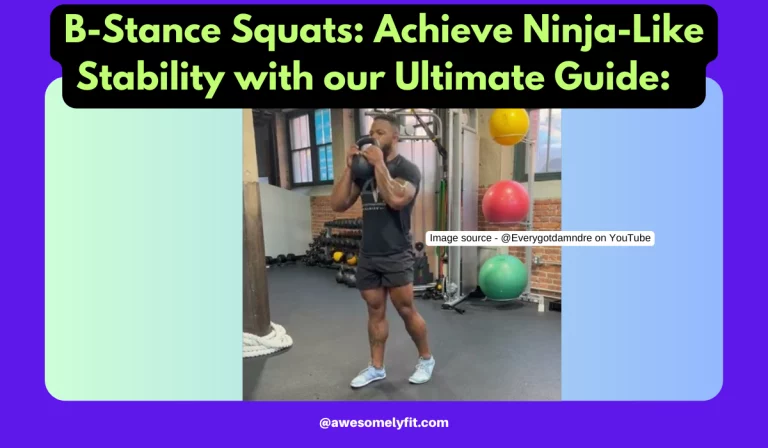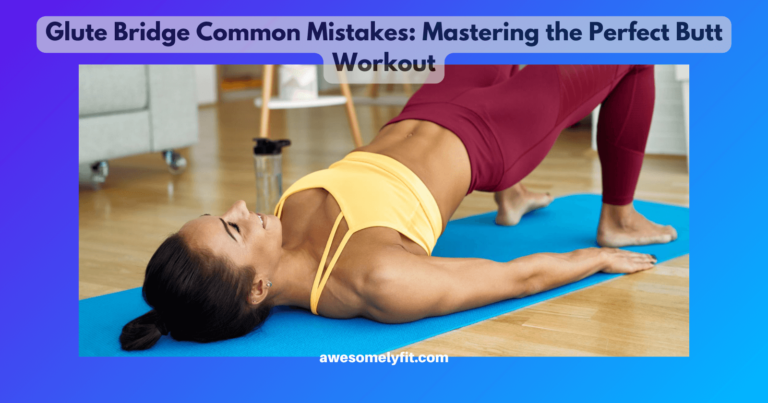Why the B-Stance RDL May Be An Even Better Posterior Chain Exercise Than Deadlifts
Introduction:
Hey, there reader!! Are you sick of having glutes that resemble flat and saggy pancakes? I do have some positive news for you, though! Today, we’re going to discuss a fantastic exercise called the B-stance RDL that will quickly make your buttocks firm and perky.
This exercise is a variation of the single leg deadlift, which targets the glutes and hamstrings while also improving balance and stability. To perform the B-stance RDL, stand with one foot slightly behind the other in a squat position.
Hold dumbbells in your hands and hinge at the hips, lowering the dumbbells towards the ground while keeping your back straight. Return to the starting position by engaging your glutes
In this piece, we’ll be exploring the details of this strange-sounding exercise that is perfect for exercisers looking to add variation to their training workouts.
Here’s what to anticipate in the article:
- B-stance RDL: What Is It?
- Why should you incorporate B-stance RDLs into your exercise regimen?
- How to properly execute a B-stance RDL in detail
- Typical mistakes people make and how to prevent them when performing B-stance RDLs
- Advice for improving your B-stance RDLs
But hold on! Let me tell you the tips and tricks you’ll be missing out on if you exit this page before you take the time to read about them.
- the opportunity to lastly tone those hamstrings and hips
- the joy of successfully completing a novel exercise and enhancing your fitness
- Possible harm from using improper form and method
- the satisfaction of making growth and getting better every day
Stay with us as we begin the B-stance RDL exercises to reap all the advantages for building the right strength with deadlifts.
This deadlifts exercise is no joke, so please believe me when I say that, but don’t fear, we’ll go over it step by step so you can master it like a pro. So grab a resistance band or a dumbbell, get ready to move and let’s start training!

B-stance The RDL (Romanian Deadlift) exercise is a variant of the standard deadlifts exercise in which the feet are placed in a staggered alignment with one foot slightly in front of the other. This exercise enhances balance and stability while focusing mainly on the hamstrings, glutes, and lower back muscles.
A brief explanation of its benefits
B-stance RDLs offers a number of advantages, including:
- Enhances stability and balance.
- Increased stimulation of the glutes and hamstrings.
- Compared to conventional RDLs, less strain is placed on the lower back.
- increased flexibility and movement of the hips.can aid in rebalancing the muscles on the left and right sides of the body.
- Can be a useful exercise for both injury prevention and recovery.
Overall, adding B-stance deadlift exercises into your workout program can help you reduce the risk of hip and leg injury while achieving greater strength and mobility in your lower body.
Proper Form and Technique
As your favorite coach, I want to make sure you are performing your B-stance RDLs and deadlifts properly for maximum leg strength. Because, let’s face it, we’ve all experienced those moments in the gym when we weren’t quite positive if we were performing leg exercises correctly.
But don’t worry; I’m here to show you how to perform B-stance RDLs correctly in both form and technique to strengthen your legs and improve your deadlift. So take a weight and let’s begin!
Let’s learn how to do the B-stance RDL(Romanian Deadlift) –
- Starting with your feet hip-width apart, adopt a “B-stance” by placing one foot just behind the other.
- Resistance bands, dumbbells, kettlebells, or barbells should be held in both hands.
Hinge forward at the hips while maintaining a small bend in your front knee while keeping your core engaged and your spine neutral. - Without lifting your back foot, lower the weight toward the ground.
- At the bottom of the move, pause for a short moment before pulling yourself back up to the starting position using your glutes and hamstrings.
- Perform 8-15 reps on each side, before switching sides.
- To prevent injury and maximize the effects of the exercise, keep your form correct the entire time you are working.
Here are a few suggestions to not screw up your lifting form, especially when performing exercises like the stance deadlift and rdls.
- Pay attention to your leg positioning to ensure proper form.
- Maintain a balanced weight distribution between your two feet.
- Maintain shoulder-width distance between your hands.
- Maintain a neutral but rigid posture and engage your core.
- Keep your front leg slightly bent.
- As you lift your torso back up, concentrate on pulling the weight using your hamstrings and glutes.
- You’ll be able to perfect the B-stance RDL and reap its benefits only with consistent efforts and patience.
Keep lifting!
Muscles Targeted by the B-stance RDL
B-stance rdl muscles worked:
The B-stance RDL is a powerful leg exercise that works the deadlift muscles and targets the rdls muscles.
Targeting the leg muscles, specifically the glutes, hamstrings, and lower back muscles, the deadlift exercise is particularly efficient including the deadlift and Romanian deadlift (RDLS).
- Glutes: B-stance RDL is one of the better exercises for the gluteus maximus, the largest muscle in the buttocks. This muscle extends the hip, which is necessary for motions like sprinting, jumping, and squatting.
- Using strength training exercises to strengthen the glutes can result in better athletic performance, reduced lower back pain, and a better-looking butt.
- Hamstrings: They are located on the back of the leg, the hamstrings are a trio of muscles. These muscles, which are necessary for hip extension and knee abduction, can be worked out with the B-stance RDL.
- It is possible to increase athletic performance and lower the chance of hamstring strains and other injuries by strengthening the hamstrings.
- Lower Back muscles: Erector spinae, which stretch along the entire length of the spine, are also targeted by the B-stance RDL. The ability of these muscles to extend the spine is crucial for keeping good posture and avoiding lower back pain.
- A strong and healthy spine can help you lift heavy objects, run, jump, bend, and improve your general athletic performance. It can also improve your daily living.
- Core: Strong core muscles are necessary for the B-stance RDL in order to keep stability and balance while performing any form of activities be it both on or off the field. This implies that the action also involves the rectus abdominis, obliques, and other core muscles.
- A strong core can enhance general body function, boost athletic ability, and lower the risk of lower back pain.
The B-stance RDL is a fantastic exercise for simultaneously working the deadlift and leg muscles, making it a wonderful addition to any exercise program.
Also, as the B-stance RDL is a horizontal angle movement. Where the hip, knee and ankle get extension in the horizontal plane.
So to achieve a complete engagement and muscle building, we need to add a vertical angle movement like the B-stance Hip Thrusts.
B-Stance Hip Thrusts work the same trio of muscles, but as they work in the vertical plane, they compensate and combine.the goodness of working the muscles in both the planes.
Thus giving the glutes, quadriceps, calves, hamstrings and other stabilizer muscles some new stimulus and results in better muscle gains.
Variations and Progressions of the B-stance RDLs

The B-stance RDL is a versatile exercise that targets multiple muscle groups, including the legs. It can be modified to increase difficulty and incorporate deadlift movements.
Here are some variants and progressions that you may use for leg exercises, including the stance deadlift and Romanian deadlifts (RDLs).
- Dumbbell B-stance RDL: In place of a barbell, dumbbells are held in each hand in this variant. Your core and stability are put under more stress.
- Single-leg B-stance RDL: In this sequence, the exercise is carried out on one leg rather than two. It intensifies the work on the glutes and hamstrings while also increasing the difficulty of balance and stabiity.
- Deficit B-stance RDL: In this variant, the exercise is performed while standing on an elevated surface, like a step or platform. This extends the range of movements and further tests your stability and balance.
- Front Foot Elevated B-stance RDL: In this variation, the front foot is raised on a tiny platform, stressing the glutes and hamstrings even more.
- Rear Foot Elevated B-stance RDL: The quads and glutes are given more attention in this variation, where we elevate the back foot on a small platform.
You can integrate these adjustments and progressions into your exercise program to keep your B-stance RDL challenging and to focus on various muscle groups, including the leg muscles.
To prevent injury, it’s critical to progressively increase the difficulty of the stance deadlift exercise and stress proper form and technique, focusing on the leg muscles.
Additionally, incorporating rdls into the routine can further enhance strength and stability.
Here is my personal experience with using B stance deadlifts variations

I recently tried out these B stance deadlifts, where you take a staggered stance with one foot forward. Let me tell you – they’re no joke! My legs were shaking trying to balance while lowering the weight. But I could feel it totally targeting my glutes and hamstrings more than a regular deadlift.
When I added dumbbells too, man did that up the challenge! Trying to stop the weights from swinging all over made me engage my core big time. I was impressed by how switching up my foot position and using dumbbells instead really worked muscles in new ways.
I’d gotten into a deadlift rut, doing the same old sets every week. If you wanna fire up those glutes and challenge your balance in a brand new way, give B stance deadlifts a shot! Dumbbells take it to the next level too. My legs are still sore but I know mixing up these creative variations is going to get me stronger overall. Give ‘em a try next back day!
Tips for an Effective B-stance RDL Workout
The following advice can help you perform a B-stance RDL exercise effectively for your legs.
- Start with proper form and technique: To avoid injury and optimize results, make sure you have mastered the proper form and technique before adding weights.
- Start with bodyweight only: Before adding weights, start your workout with bodyweight movements. This aids in maintaining correct form and guarantees that you are working the appropriate muscles.
- Weights should be progressively increased as you advance in order to challenge your muscles.
- Include variations: Include various B-stance RDL variations in your exercise to avoid boredom and boost efficiency.
- Pay attention to the muscles you are targeting during the exercise as you concentrate on the mind-muscle connection. Observe how the muscles feel as they are being exercised.
- Don’t forget to stretch after working out: it can help avoid injury and muscle soreness.
These pointers will help you perform a B-stance RDL exercise that effectively works your hips, hamstrings, and lower back while engaging your legs.
Common Mistakes and Safety Tips
As a fitness instructor, I’ve witnessed plenty of B-stance RDLs gone wrong, particularly when it comes to the leg. So, here are some safety advice and typical mistakes to avoid when working on your leg muscles.
Typical Mistakes that lifters make:
- Putting on excessive weight while losing form
- Bending at the pelvis instead of rounding the lower back
- Lifting the rear foot off the ground would be useless to the lifter as the exercise is mainly working the balance and stability of the feet.
- Not using the core, which can cause instability and prove harmful.
Safety Tips & Advice:
- Prior to raising the weight, start with a lighter weight and concentrate on perfecting your form.
- Instead of rounding the back, keep the spine straight and hinge at the hips.
- Throughout the entire range of motion, maintain a firm ground position with both feet.
- Keep your balance and protect your lower back by contracting your core muscles.
Keep in mind that using the correct form for leg exercises, such as Romanian deadlifts (RDLS), will help you get the most out of this exercise and avoid getting hurt. Glad hoisting!
Conclusion
In conclusion, B-stance RDL is a very efficient leg exercise for hamstring, glute, and lower back muscle strengthening. It is a great supplement to any exercise regimen, especially for those trying to gain more stability and balance.
I strongly advise you to try adding B-stance RDL and leg into your next workout if you haven’t already. Start with light weights and pay attention to form and skill.
Consider progressing to more difficult versions of B-stance RDL, such as single-leg B-stance RDL or adding resistance bands, to optimize the advantages of this exercise. RDLS can be a great way to challenge your balance and strengthen your posterior chain.
You can achieve your fitness objectives and lower your risk of injury by incorporating B-stance RDLs into your leg routine. Therefore, don’t be hesitant to give it a shot and assess the outcomes for yourself!
FAQs
What is a B-stance RDL?
B-stance RDL is a unilateral exercise that targets the hamstrings, glutes, and lower back muscles.
What are the benefits of doing B-stance RDLs?
B-stance RDLs can improve your balance, and stability, and increase strength in your hamstrings, glutes, and lower back muscles.
Can beginners do B-stance RDLs?
Yes, beginners can start with body weight and light weights to master the technique and gradually increase the weight as they get comfortable.
How many reps and sets should I do for B-stance RDLs?
It’s recommended to start with 3 sets of 8-12 reps on each side and gradually increase the sets and reps.
How often should I do B-stance RDLs?
It depends on your fitness level and goals, but you can incorporate B-stance RDLs in your lower body workout routine once or twice a week.
What equipment do I need for B-stance RDLs?
You can perform B-stance RDLs with resistance bands, dumbbells, kettlebells, or barbells.
Can B-stance RDLs help with lower back pain?
Yes, B-stance RDLs can help strengthen your lower back muscles, which can alleviate lower back pain.
Is B-stance RDL a safe exercise?
Yes, B-stance RDLs are generally considered safe, but it’s important to use proper form and technique to avoid any injury.
Can I do B-stance RDLs if I have knee problems?
B-stance RDLs is a hamstring and glute-dominant exercise that places less stress on your knees compared to squats and lunges. However, it’s important to consult with your doctor before starting any exercise program.
Can I do B-stance RDLs if I have balance issues?
B-stance RDLs can help improve your balance and stability, but if you have severe balance issues, it’s important to start with a stable surface and progress gradually.
What is the difference between B stance RDL and regular RDL?
The main difference between B stance RDL and regular RDL is the stance of the feet.
B stance RDL involves having one foot slightly behind the other, while RDL is performed with feet shoulder-width apart.
B stance RDL places more emphasis on the stabilizer muscles and requires greater balance, while RDL primarily targets the hamstrings, glutes, and lower back.
Is B stance RDLs compound exercise?
Yes, b stance rdls are considered a compound exercise as they target multiple muscle groups, including the hamstrings, glutes, and lower back, and require coordination between these muscle groups to perform the movement correctly.
Are DB or BB RDLs better?
Both dumbbell b stance Romanian deadlift and barbell (BB) Romanian Deadlifts (RDLs) have their own benefits and drawbacks.
DB RDLs are great for unilateral training and offer more balance and control, while BB RDLs allow for heavier weights to be lifted and can be more effective for targeting the lower back.
The choice ultimately depends on individual preferences and goals. It is recommended to incorporate both DB and BB RDLs into your workout routine for variety and to target different muscle groups.
What does the B in B stance stand for?
the “B” in “B-stance” means “balance.” because this exercise is all about keeping a stable and balanced position while developing strength and mobility,
RDL vs B stance RDL
Here are some key differences between a traditional Romanian Deadlift (RDL) and a B-Stance RDL:
Traditional RDL:
Stance: Hip-width.
Weight Distribution: Even.
Engagement: Balanced posterior chain.
B-Stance RDL:
Stance: Staggered.
Weight Distribution: Emphasis on front leg.
Challenge: Enhanced balance.
Focus: Targets unilateral strength and stability.

👋 I am Rakesh Sonawane, a personal trainer with around half a decade of working experience. I have been fortunate enough to have trained people from all walks of life.
I created this site to simplify the path of getting fit and healthy as the internet is filled with too complex and useless info.
My website content is well-planned, thought, and well-researched before being published on the site for you to read. Hopefully, you will enjoy my helpful, practical content.






